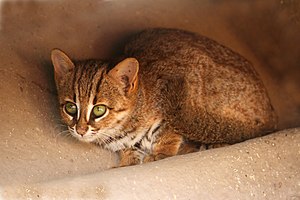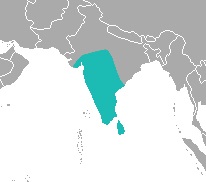Rust cat
| Rust cat | ||||||||||||
|---|---|---|---|---|---|---|---|---|---|---|---|---|

Rust cat ( Prionailurus rubiginosus ) |
||||||||||||
| Systematics | ||||||||||||
|
||||||||||||
| Scientific name | ||||||||||||
| Prionailurus rubiginosus | ||||||||||||
| ( I. Geoffroy Saint-Hilaire , 1831) |
The rust cat ( Prionailurus rubiginosus ) is a small species of cat closely related to the bengal cat ( Prionailurus bengalensis ). It occurs wild in India and the island nation of Sri Lanka .
features
Rust cats weigh 1.1 to 1.6 kg, with males being heavier than females. The head body length is 35–48 cm, the tail length 15–30 cm. This makes the rust cat one of the smallest small cats . The fur of the rust cat is short. It is named after the rust-brown spots on the gray-yellow underground fur. It looks very similar to the Bengal cat, but its spots are less clear and make a blurred impression.
distribution and habitat
There are two separate populations of the rust cat, one on the southern tip of India and the other on Sri Lanka. You inhabit different habitats here. The rust cats of Sri Lanka are residents of dry zones and rainforests . They can be found there both in the lowlands at sea level and in mountain heights up to 2100 m. The Indian populations, on the other hand, are only at home in dry, open areas. According to one theory, the competition of the Bengal cat has displaced the rust cat from the forest habitats on the Indian subcontinent. In Sri Lanka, on the other hand, there are no Bengal cats that could have driven rust cats out of the forests.
On the Indian mainland, the distribution area is incoherent. It is believed that the species occurs only in the south and in the western central parts. A single specimen was detected in 1975 in distant Jammu and Kashmir .
Reproduction
The oestrus of rust cats is around five days. Rust cats usually have one cub per litter, occasionally up to three. The gestation period is on average 67 days.
Lifestyle and diet
Little is known about the behavior of the rust cat in the wild. Most observations on behavior come from captive animals. Rust cats are crepuscular and nocturnal loners whose way of life is largely similar to the bengal cats. Although they can climb well, they mostly move on the ground. Their prey includes birds, mice, lizards and insects. According to local reports, rust cats are often spotted after heavy rainfall and then prefer to hunt rodents and frogs.
Subspecies
There are three subspecies of the rust cat. The nominate form from India and also two subspecies on the island of Sri Lanka:
- P. r. rubiginosus , South India
- P. r. koladivinus , arid regions of Sri Lanka
- P. r. phillipsi , wetlands in southwest Sri Lanka
Persistence and Threat
The rust cat is classified as threatened (vulnerable) by the IUCN (International Union for Conservation of Nature and Natural Resources) . Hunting and trade in animals are generally prohibited in India and Sri Lanka. In Sri Lanka, the trade in domesticated animals is strictly controlled. One reason for the decline of this animal species is the decimation of their habitat due to the clearing of forests and the advancing use of natural areas for human habitat. Another reason is the fur trade.
The Sri Lankan rustcat is currently kept in seven European zoos in Germany, France, the Czech Republic and England. The animal species classified as threatened is an animal of the European Endangered Species Program (EEP). The Frankfurt Zoo keeps the International Stud Book (ISB) .
literature
- Kristin Nowell, Peter Jackson: Status Survey and Conservation Action Plan. Wild cats. IUCN - The World Conservation Union, 1996. ISBN 2-8317-0045-0 , pp. 72-74. (PDF download; 23.4 MB)
- John Seidensticker, Susan Lumpkin: Big Cats. Jahr-Verlag, Hamburg, ISBN 0-86438-233-2 , p. 44.
- Don E. Wilson, Russell A. Mittermeier (Eds.): Handbook of the Mammals of the World. Volume 1: Carnivores. Lynx Edicions, 2009, ISBN 978-84-96553-49-1 , p. 161.
Web links
- Species profile rust cat; IUCN / SSC Cat Specialist Group in English
- Prionailurus rubigenosus in the endangered Red List species the IUCN 2006. Posted by: Cat Specialist Group, 2002. Retrieved on 11 May, 2006.
- Animal Diversity Web: Prionailurus rubiginosus - rusty-spotted cat , accessed May 18, 2013.
- [1] BBC: the rusty spotted cat
Individual evidence
- ↑ a b c d e Wilson & Mittermeier, 2009
- ↑ John Seidensticker, Susan Lumpkin: Big Cats, p. 44.
- ^ Kristin Nowell, Peter Jackson: Status Survey and Conservation Action Plan. Wild Cats, p. 72.
- ^ Kristin Nowell, Peter Jackson: Status Survey and Conservation Action Plan. Wild Cats, p. 72.
- ↑ Zoo animal list , accessed on May 18, 2013.
- ^ Frankfurt Zoo breeding programs
